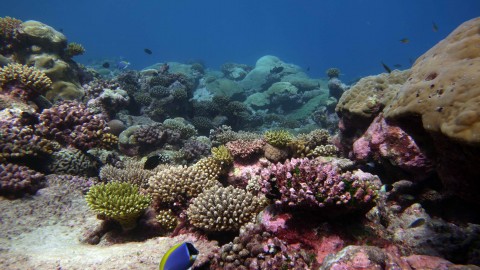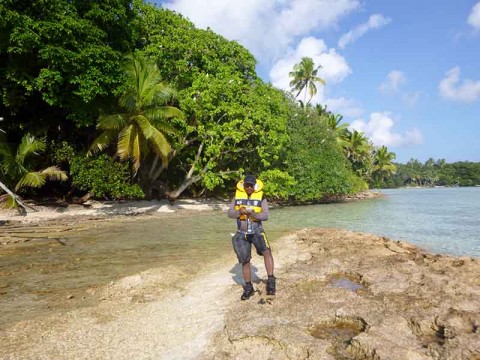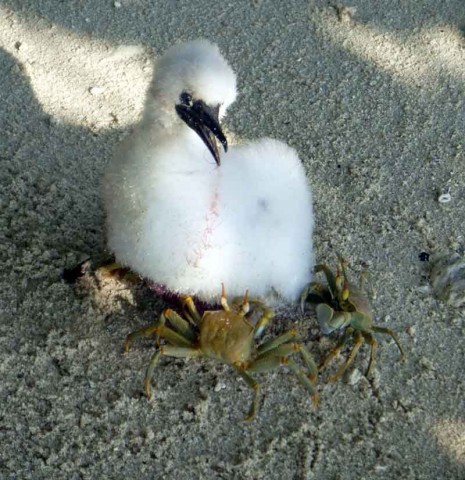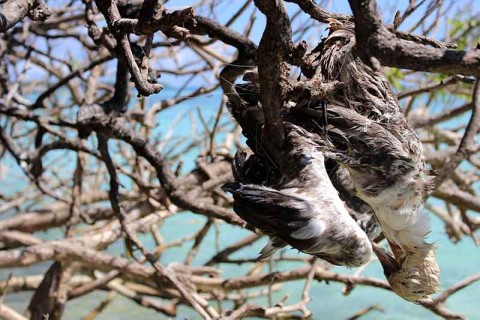BIOT Science Expedition 2014 - Diving the dropoff and working with seabirds… Day 3
Diving the drop off and working with seabirds
We’re settling into a routine on board now so deploying for the morning dive was somewhat slicker than yesterday’s attempt. Despite a couple of boats being out the water for running repairs and the distraction of a playful pod of dolphins en route we still plunged in for the days first dive well ahead of schedule. We could hear the dolphins whistles throughout our submersion but they’re really wary of divers and only ventured close enough to be visible on a couple of occasions. An invisible choir for our listening pleasure whilst working the reefs.

The site we chose was a busy one, rich with corals and clouds of fish. From previous dives here we know that the place is prone to strong currents and this is evident in the abundance of anemones. They like to have the tentacles wafted by the moving water. With the anemones come the inevitable anemonefish. And special for this site, a large number of these beautiful little anemone symbionts are the endemic Chagos Anemonefish.

These are not the only fish that provided a spectacle while we worked, a small snapper proved to be very tame and kept flitting from dive pair to dive pair for company. More to come on the marine side of things tomorrow...for today I thought I’d ask Pete to fill you in on the birding programme in a little more detail so here are a few words from him...


“Today presented the opportunity for me to introduce Loius to a different island in the Chagos and to show him some techniques for monitoring breeding seabirds. An early start saw us dropped on the beach. Fortunately there was no requirement to swim ashore. We then walked the circumference of the island counting the number of nesting Red-footed Booby using a standard technique called Apparently Occupied Nests (AONs). I am looking at trying to confirm the peak breeding period for this species in the Chagos (they nest throughout the calendar year) so I take AON a stage further and try to ascertain at what stage of the breeding cycle the birds are at, e.g. eggs, small chicks, large chick, etc. This is possible for many nests that are low down on trees, but does normally involve wading out in to the sea to look back at the shoreline! This expedition’s survey data will be combined with counts I have made at other times of the year to and unravel the breeding phenology of this species and, whether it is linked to any oceanographic events.

Loius witnessed first-hand some of the dangers and challenges facing seabirds, not only in the Chagos but throughout the world. The first example was of a small chick that had fallen from its nest on to the beach and was being devoured by crabs. Whilst sad and grisly this is a natural process. The distressing example of the challenges facing seabirds worldwide was of an adult Red-footed Booby hanging upside-down, dead in a tree. Despite there being no fishing in the Chagos Marine Protected Area, this bird had become tangled in monofilament fishing line, carried it back to its nesting/roosting tree where it became snagged and died, likely through exhaustion from trying to free itself.

Despite the challenges to the breeding seabirds, they are faring well in the Chagos. Today’s example of the importance of the Chagos for seabirds comes from the Red-footed Booby. Throughout the Indian Ocean breeding colonies of this species have declined or totally disappeared. Historically this was the case in the Chagos too but things are changing. In the first major survey of the breeding seabirds in 1996 the island Loius and I looked around today held no breeding Red-footed Booby. Today, thanks to some surviving magnificent Takamaka trees on the shoreline that provide a suitable nesting platform, this island had a minimum of 169 breeding pairs. Globally there are very few oceanic islands, atolls or archipelagos that can boast of increasing or recently increased breeding seabird numbers; the British Indian Ocean Territory can.
The Chagos Archipelago is a sanctuary for breeding seabirds in an ocean and world where seabirds are generally not faring well. Everything should be done to protect this breeding stock and where possible, facilitate an environment in which they can increase breeding numbers. With sympathetic shoreline habitat management that would increase native trees that seabirds prefer to breed in e.g. Takamaka, Pisonia and Barringtonia, coupled with an invasive mammal eradication programme, the British Indian Ocean Territory could be the Indian Ocean reservoir of seabirds to repopulate protected but impoverished islands elsewhere. Ecological improvement of oceanic islands is not a green dream; it is occurring worldwide and has already been achieved in other UK Overseas Territories. The time must surely be near where the will and the finances will become available to allow the ecologically devastated islands of this wonderful archipelago to be restored to something of their former glory.”

